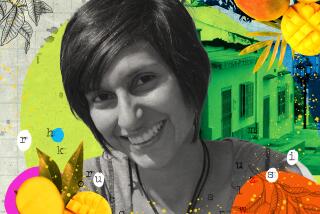COLUMN ONE : Latina Writers Are Silent No Longer : Fresh, frank voices are fueling a surprising literary boom in Central and South America after centuries of macho-minded rejection.
SANTIAGO, Chile â When Ana Pizarro returned to Chile in 1991 after 17 years in exile, she offered the manuscript of a novel to a local publishing house, which rejected it.
Pizarro, 53, was discouraged but not surprised. As a scholar of Latin American literature, she knew that innumerable women writers in this region had been silenced for centuries by macho-minded prejudice and rejection.
But through a friendâs contacts with another publisher, Pizarroâs âThe Moon, the Wind, the Year, the Dayâ finally was printed last June.
Then, much to her surprise, the Sunday book section of the conservative El Mercurio, Chileâs most influential newspaper, splashed the author and her novel on its cover.
Now, the publisher tells Pizarro that her book is selling well--just one sign among many of a growing trend in Latin America, where women authors are enjoying unprecedented success.
âThere is an opening for feminine writing,â Pizarro said in an interview. âI believe the field is opening up more and more.â
Books by Latin American women have become international bestsellers, in what some critics are calling a new boom. It is reminiscent of Latin Americaâs celebrated--all-male--literary explosion in the 1960s when luminaries such as Gabriel Garcia Marquez of Colombia, Carlos Fuentes of Mexico and Mario Vargas Llosa of Peru attracted international recognition.
The regionâs latest crop of big-name writers is headed by a Chilean, Isabel Allende, whose books, including the novel âThe House of the Spirits,â have sold more than 10 million copies worldwide.
Literary scholars, while reluctant to belittle Allendeâs knack for telling a popular story, say privately that other women in Latin America are producing richer, more literary material; many of these also are achieving the big sales and critical acclaim once reserved almost exclusively for men.
Because books are expensive in Latin America and education levels generally are low, writers of either gender still lack the mass readership that many authors enjoy in the United States.
But economic development, population growth and rising education levels have expanded the market for books, creating openings for new writers.
Meanwhile, gender bias has been breaking down throughout Latin America. Women have more opportunities for education, career success and intellectual freedom. This has translated into a larger public of women readers with greater interest in serious feminine literature. It also has meant that more men are discarding prejudices against reading what women write.
âThere are scads of women emerging at this moment, at least in Chile and apparently in Mexico and Argentina also,â said Beatriz Berger, editor of El Mercurioâs book section.
Growing numbers of Latin American women are being published outside their own countries, including in the United States. (Some finance their writing careers by teaching at American universities; a few, including Allende, have married Americans.)
âSome of them have leverage with American publishers, and they are the ones that get the attention, but there are hundreds more good women writers out there,â said Kirsten Nigro, a professor of Romance languages at the University of Cincinnati.
Many others are little known abroad but are changing the face of literature in their home countries.
âOne of the most original things being produced in Latin America is womenâs voices,â said Marjorie Agosin, a Chilean poet and professor of Latin American literature at Wellesley College in Massachusetts. Much of the new writing reveals refreshing--sometimes even shocking--frankness by women on society, politics, sex and other subjects.
âItâs women talking about themselves in a very open way, very transparent, very daring,â Agosin said in a telephone interview. âBefore, women never spoke about how they felt, they never spoke about their sexuality. They censored themselves. Itâs new in the sense that women are doing it with great openness.â
Claudia Ferman, an Argentine who teaches Latin American literature at the University of Richmond in Virginia, called the trend a Pandoraâs box: âYou open it, and the most unexpected things come out, because this is the classic phenomenon of when someone is silenced, then there are many things in fermentation. And that, it seems to me, is what is attracting the public . . . that novelty of vision.â
For example, womenâs erotic poetry is breaking ground in Caribbean Basin countries. In other parts of the region, womenâs poetic expression is invading the traditional territory of narrative writing âso there is a kind of very lyric narrative,â Ferman said. âWhat we are seeing is that, when women start writing massively, they change not only what is said, but the genre it is said in.â
When experts are asked who are the best women writers in Latin America today, the most-mentioned names include novelists Elena Poniatowska of Mexico, Diamela Eltit of Chile and Cristina Peri Rossi of Uruguay.
Poniatowskaâs novels âHereâs Looking at You, Jesusâ and âTinisimaâ are âtestimonial narrativesâ that look at history through the eyes of women who lived it.
The avant-garde Eltit challenges conventional thinking with stories about misfits, rebels and others on societyâs fringe.
Peri Rossi, who lives in Spain, deals with the confused sexual and national identities of the exiled characters in her best-known novel, âThe Ship of Fools.â
Dozens of other women have well-established reputations, and scores more are seen as promising new talents.
David Geis, head of the Spanish and Portuguese department at the University of Virginia, is especially enthusiastic about Mexican novelist Maria Luisa Puga. He said her works are âpowerful and lyrical,â exploring the condition of women in developing countries with critical realism.
Until the last decade or two, women in Latin America did not have opportunities that men did âto make a life in writing, to think they could be writers,â Geis said. A few exceptional women did break through. Chileâs Gabriela Mistral won the Nobel Prize for Literature in 1945 with her earthy, maternal-voiced poetry, and Brazilian Clarice Lispectorâs reflective novels and short stories are ripe with provocative ambiguity.
But only since the early 1980s have greater numbers of Latinas gained broader access to publishing circles, to the press and to the literary Establishment.
âTheyâve broken in,â Geis said. âI think weâve pretty much eliminated the macho mind-set, and we are all richer for it.â
Publishers are richer too.
Carlos Orellana, editor in Chile of the international publishing firm Editorial Planeta, observed: âReally, there is a pretty spectacular apogee in Latin America, from the point of view that today the best-selling authors--Garcia Marquez aside--are women.â
The biggest blockbuster has been Allendeâs âThe House of the Spirits,â followed by Mexican Laura Esquivelâs first novel, âLike Water for Chocolate.â
Both dramatize Latin American cultural virtues and vices with storytelling virtuosity and enticing touches of magic realism--or âmagic feminism.â
Orellana said their huge success has helped pave the way for others.
âIt contributes to knocking down complexes and prejudices--in women writers, who dare to do more now, as well as in publishers who could have misgivings about the commercial possibilities of publishing women,â he said.
Pizarro, a researcher in culture at Santiago University, said that since the 1970s, womenâs fiction in Latin America has become more daring, while maintaining a female identity.
âIt is a writing that has great aesthetic quality and speaks from another place, a place where sensitivities are different, where the relationship with reality is a little different from what we are used to in fundamentally masculine writing,â she said.
Many women, such as novelist and poet Carmen Bullosa of Mexico, have developed artful ways of interpreting history through elaborate symbolism, she added.
They are âtaking on history, and in a new way,â she said. âIt is a de-solemnized history--open, playful.â
In her novel âLlantoâ (Crying), Bullosa jokingly questions conventional versions of Mexican history, examining it through the eyes of the Aztec emperor Montezuma.
Traditionally, interpretation of such âseriousâ subjects in Latin American literature had largely been left to men.
Women writers were around but went unnoticed, Pizarro said. âThey didnât have a tribune. And because they didnât have a tribune, they couldnât advance in their aesthetic projects, because the only way to advance is to publish.â
Then came the political and ideological ebullience of the 1960s, when revolutionary movements and social activism spread through the region.
âThere was a great process in Latin America of affirmation of identities,â Pizarro said. âStarting from that time, the voice of the woman begins to emerge in the rest of the countries of the continent.â
Pizarro earned a doctorate in literature at Franceâs Sorbonne in 1968, then became a professor at Chileâs University of Concepcion, a hotbed of social and political activism.
Like thousands of other leftists, she went into exile in 1973 after a right-wing military coup harnessed Chile with a harshly repressive regime.
In the 1970s and 1980s, when much of Latin America was ruled by military governments, women also played an important role in resisting dictatorships and pushing for democracy.
âMen give them a place, because they need women in those struggles,â said Ferman of the University of Richmond.
She said a feminist movement and more assertive writing by women have sprung from those political origins.
âThey have acquired permission, they have permitted themselves to move ahead, to have a voice,â she said. âThey begin to understand that they were silenced.â
The progressive return to democracy throughout Latin America since the early 1980s has permitted more open discussion, and that has further contributed to the surge in womenâs literature.
The struggle for literary equality has been a long one in Latin America.
Sister Juana Ines de la Cruz, a Roman Catholic nun in 16th-Century Mexico, ran up against a wall of church censorship with her writing. Sister Juana is best known for her penetrating poetry, such as âFirst Dream,â a metaphorical interpretation of dreaming and awakening.
From the 1920s through the 1950s, pioneers included Maria Luisa Bombal of Chile, who wrote subjective, stream-of-consciousness novels about women in reclusion, and Rosario Castellanos of Mexico, whose novels and short stories described native life and racial discrimination in the southern state of Chiapas.
While women authors have come a long way in Latin America, they continue to lag behind their American and European sisters. Silvia Pellarolo, a professor of Hispanic literature at UCLA, said many continue to go unnoticed because what they have to say is ânot very appealing to a wider audience or to the owners of the publishing houses, who are usually men.â
âWhat weâre seeing is just the tip of the iceberg, and there are many, many, many other womenâs voices that are completely ignored,â Pellarolo said.
More to Read
Sign up for Essential California
The most important California stories and recommendations in your inbox every morning.
You may occasionally receive promotional content from the Los Angeles Times.










